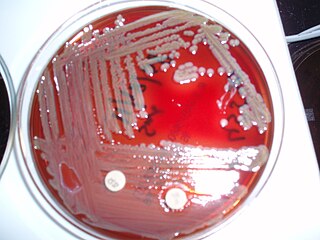Related Research Articles

The family Flavobacteriaceae is composed of environmental bacteria. Most species are aerobic, while some are microaerobic to anaerobic; for example Capnocytophaga and Coenonia.
Massilia albidiflava is a Gram-negative, rod-shaped, oxidase and catalase positive, non-spore-forming motile bacterium from the genus Massilia and the family Oxalobacteraceae which was isolated with Massilia dura, Massilia plicata, and Massilia lutea from soil samples in southeast China.
Massilia dura is a Gram-negative, rod-shaped, non-spore-forming bacterium from the genus Massilia and family Oxalobacteraceae, which was isolated with Massilia albidiflava, Massilia plicata, and Massilia lutea from soil samples collected from southeast China. Colonies of M. dura are hard and compact and their color is pale white to yellow.
Massilia lutea is a Gram-negative, non-spore-forming, short rod-shaped, motile bacterium with a peritrichous flagellum from the genus Massilia and family Oxalobacteraceae.
Chryseobacterium taklimakanense is a Gram-negative and rod-shaped bacteria from the genus of Chryseobacterium.
Leeuwenhoekiella is a strictly aerobic bacterial genus from the family of Flavobacteriaceae.
Prauserella is a Gram-positive, aerobic and non-motile genus from the family of Pseudonocardiaceae.
Thalassotalea is an aerobic and chemo-organo-heterotrophic genus of bacteria from the family Colwelliaceae which occur in the ocean and in sea ice.
Algimonas arctica is a Gram-negative and aerobic bacterium from the genus of Algimonas which has been isolated from sand from the Arctic.
Marinicauda pacifica is a Gram-negative and aerobic bacterium from the genus of Marinicauda which has been isolated from deep seawater.
Gramella flava is a Gram-negative, aerobic and motile bacterium from the genus of Gramella which has been isolated from seawater.
Salinimicrobium nanhaiense is a Gram-negative, facultatively anaerobic and rod-shaped bacterium from the genus of Salinimicrobium which has been isolated from sediments from the South China Sea.
Subsaxibacter arcticus is a Gram-negative, aerobic and rod-shaped bacterium from the genus of Subsaxibacter which has been isolated from intertidal sand from Kongsfjorden in Svalbard.
Oceanihabitans is a genus of marine bacterium in the family Flavobacteriaceae. It contains a single species, O. sediminis. It is aerobic, Gram-negative, rod-shaped, and motile by gliding. O. sediminis produces flexirubin pigments. It is positive for cytochrome c oxidase and catalase. O. sediminis can use glucose, mannose, maltose and adipic acid as sole carbon sources for chemoheterotrophic growth. It is a chemoorganotroph and is chemotaxonomically characterized by the presence of menaquinone 6 (MK-6). The type strain is S9-10T.
Antarcticimicrobium is a bacterial genus from the family Rhodobacteraceae.
Antarcticimicrobium luteum is a Gram-negative, short-rod-shaped, mesophilic, aerobic and non-motile bacterium from the genus of Antarcticimicrobium which has been isolated from marine sedimens from the Masan Bay in South Korea.
Antarcticimicrobium sediminis is a Gram-negative, aerobic and non-motile bacterium from the genus of Antarcticimicrobium.
Arcticiflavibacter is a Gram-negative, aerobic and rod-shaped genus of bacteria from the family of Flavobacteriaceae with one known species.
Changchengzhania is a Gram-negative, aerobic, rod-shaped and non-motile genus of bacteria from the family of Flavobacteriaceae with one known species.
Meridianimaribacter is a Gram-negative and rod-shaped genus of bacteria from the family of Flavobacteriaceae with one known species.
References
- 1 2 3 4 "Genus: Arenitalea". lpsn.dsmz.de.
- 1 2 Zhang, Xi-Ying; Liu, Ang; Liu, Chang; Li, Hai; Li, Guo-Wei; Xu, Zhong; Chen, Xiu-Lan; Zhou, Bai-Cheng; Zhang, Yu-Zhong (1 August 2013). "Arenitalea lutea gen. nov., sp. nov., a marine bacterium of the family Flavobacteriaceae isolated from intertidal sand". International Journal of Systematic and Evolutionary Microbiology. 63 (Pt_8): 2853–2858. doi:10.1099/ijs.0.049304-0.